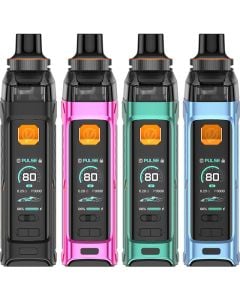If you’re in search of bigger clouds and enhanced flavours, then you might be curious about sub-ohm vaping and the great benefits it offers. Perfect for experienced vapers who’re looking for a bit more control when it comes to their experience, sub-ohm vaping uses low ohm resistance levels to create a high-powered vaping experience. Get to grips with everything you need to know about sub-ohm vaping before giving it a try.
What is sub-ohm vaping?
Sub-ohm vaping is a style of high powered DTL vaping that uses high VG e-liquids, usually with the aim of producing a thick vapour. To understand sub-ohm vaping, you need to first understand the difference between MTL (mouth-to-lung) and DTL (direct-to-lung) vaping and the experiences they offer. Find out more in our guide to MTL and DTL vaping.
Sub-ohm vaping relies on a DTL vaping style, which allows you to breathe the vapour straight into your lungs. Sub-ohm vapes tend to have large tanks, often with glass walls, and they’re designed to heat up quickly. They also have a coil with an electrical resistance lower than 1 ohm.
However, just because a vape has a coil with a resistance level of 1 ohm or less, it doesn’t mean it will necessarily offer a sub-ohm experience. It’s more complex than that.
For example, some starter kits have coils/pods with a resistance lower than 1 ohm, but would not really be considered sub-ohm vapes because they have low wattage settings, use 50/50 or high VG e-liquids, offer a MTL vape style, and have a lower vapour production.
So, while you’ll nearly always find that sub-ohm vapers use a coil resistance one 1 ohm, or less, that doesn’t necessarily mean that every low coil resistance will produce a sub-ohm experience, there are a lot of other factors that make up a sub-ohm vape.
What is an ohm and what does it measure?
An ohm is a measurement of resistance between two different points of a conductor. It lets you know how quickly electricity can be transferred between the points and can therefore be used to measure the electrical resistance of a material or an electrical device.
When it comes to vaping, ohms are used to let you know some important factors about the resistance of your coil – and how this will affect things like heat and wattage – to help you control your vapour production. Get more information in our guide to ohms and vaping.
Sub-ohm vaping used to refer quite simply to vaping with a coil resistance of 1 ohm or under, but the practice has evolved to encompass other factors. So not all coils/pods under 1 ohm would necessarily be considered sub-ohm vapes, but all sub-ohm vapes will have a resistance of 1 ohm or lower.
How sub-ohm vaping works
Sub-ohm vaping is possible when a few different factors are in play. For a start, a coil or pod with a resistance of 1 ohm or lower is used, because these low resistances make it possible for more wattage to flow through the wire or mesh, which can generate more heat and therefore produce denser vapour clouds. Through a combination of low resistances, higher wattages and adjustable airflow (which lets you cool the coil when needed), you can create a greater vapour production and flavour intensity with sub-ohm vaping.
A sub-ohm vape typically refers to an advanced or intermediate vape kit using a coil or pod with a resistance below 1 ohm. These devices generally operate at wattages above 30W and are designed for RDTL (restricted-direct-to-lung) or DTL (direct-to-lung) vaping styles, typically with high VG vape juice.
All of these factors combine to offer a higher vapour production that offers a lot more control and variation that you can achieve with a starter kit. However, that also means that sub-ohm vapes are better suited to experienced vapers.
Equipment needed for sub-ohm vaping
To achieve a sub-ohm vaping experience, there are a few bits of equipment that are essential. Here are the kind of things you should be looking for:
Sub-ohm tanks/pods
You will need a sub-ohm tank that is able to handle a high wattage, offers adjustable airflow and has a sub-ohm coil. You’ll find some handy info about power rates in our guide to wattages for vaping.
There’s also a choice to be made between pre-built and rebuildable tanks. The former are easy to use while rebuildable tanks, also known as Rebuildable Tank Atomizers (RTAs), let you customise your experience by choosing your own coils and wicks. You can also buy sub-ohm pods, which are a convenient way to enjoy sub-ohm vaping on the go.
Sub-ohm coils
When it comes to choosing coils suitable for sub-ohm vaping you’ll be looking for ones with a resistance of 1 ohm or lower. There are also a variety of materials to consider, with mesh coils often being made with kanthal, stainless steel or nickel.
Stainless steel is popular for its fast ramp-up time and clean flavour, while nickel can offer more temperature control. Kanthal is an alloy that’s affordable, durable and has a good balance between flavour and cloud production.
Vape mods
For sub-ohm vaping, you need a kit that is able to offer greater control over your wattage than the average starter or basic kit. You also need one that’s able to let you use a high wattage battery safely.
When you buy a starter kit, the battery will be designed to do the job it’s there for. When you’re looking at a sub-ohm kit, you want a high drain battery (with amp limits) that offers a safe discharge rate. Sub-ohm vaping is more demanding on the battery, so choosing one that offer a high drainage rate is essential.
Mouthpieces (drip tips)
You’ll also want to choose a suitable mouthpiece, also known as a drip tip, for your sub-ohm vape. This means looking for a wider bore or opening. This allows more air to be drawn through, making it suitable for DTL and sub-ohm vaping.
Best e-liquids for sub-ohm vaping
To maximise enjoyment and get the most out of your sub-ohm vaping experience, there are a few things to keep in mind when you’re choosing your e-liquid. These include:
- High VG vs PG ratios – Look for 70% or higher VG ratios, often displayed as 70:30, when it comes to sub-ohm vaping. That will help you achieve a thicker vapour and smooth hits.
- Lower nicotine strength – Lower nicotine mg/ml are recommended because RDTL or DTL style vaping has a stronger throat hit than MTL styles, meaning higher nicotine strengths can feel very harsh. Most sub-ohm vapers who use nicotine will stick to a 3 mg/ml vape juice, so it is important to ensure this will suit your needs.
- Varied flavour profiles – No particular flavour is better, although many sub-ohm vapers prefer fruity or sweet flavours and find that those perform particularly well in a sub-ohm set up.
You’ll find everything you need to know about which e-liquids are best with which devices in our guide to VG and PG vape juices.
Benefits of sub-ohm vaping
Sub-ohm vaping is very popular with experienced vapers who’re looking for ways to tailor their experience. Some of the big benefits are:
Bigger vapour clouds
Sub-ohm vaping is geared towards creating bigger, thicker vapour clouds, this makes it particularly popular among those vapers who are ‘cloud chasers’.
Enhanced flavour
Because you’re using more e-liquid to create thicker clouds, you’ll also notice a more intense flavour.
Smoother inhalation
Because you’ll be using e-liquids with High VG and DTL with lower nicotine levels, you should have a smoother throat hit.
Sub-ohm vaping can be a great way to get thicker, denser clouds and a more intense flavour and is well loved by experienced vapers who’re ready to customise their experiences.
Ready to start experimenting with sub-ohm vaping? Explore the great selection of sub-ohm vape kits, suitable e-liquids and accessories at Evapo.




























